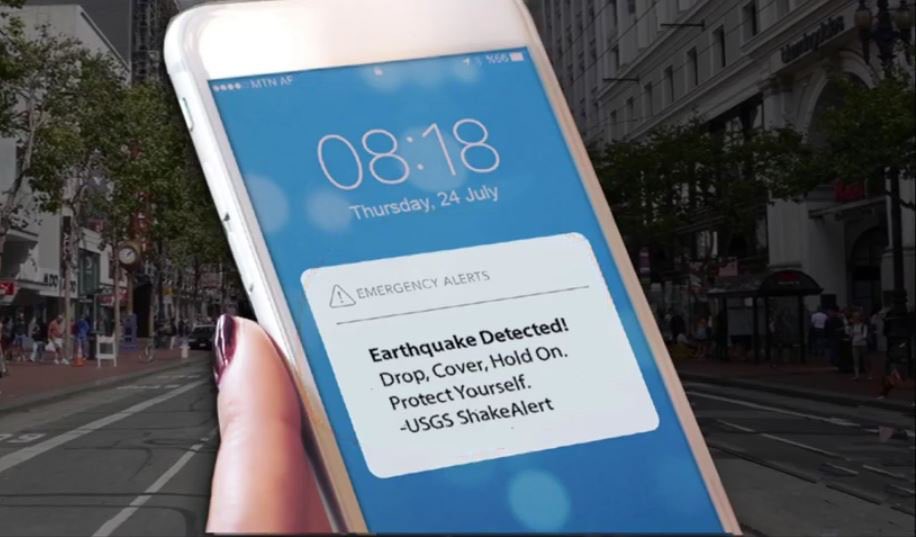ShakeAlert® in Oregon
The Cascadia Subduction Zone is a 600-mile fault that runs from northern California up to British Columbia and is about 70 to 100 miles off the Pacific coast shoreline. There have been 43 earthquakes in the last 10,000 years within this fault. The last earthquake occurred on Jan. 26, 1700, with an estimated 9.0 magnitude; it also sent a large tsunami to the coast of Japan.
The
USGS ShakeAlert® Earthquake Early Warning System is an earthquake detection tool, operated by the U.S. Geological Survey (USGS), that uses science and technology to detect significant earthquakes so alerts can be delivered to people on their cell phones before damaging shaking arrives at their location. ShakeAlert can save lives and reduce injuries by giving people seconds to take protective action, such as
Drop, Cover and Hold On, or to move away from hazardous areas if they feel shaking or get an alert.
ShakeAlert also can protect people and infrastructure by triggering other pre-programmed actions upon earthquake detection, such as slowing trains to prevent derailments, opening firehouse doors so they do not jam shut, activating hospital generators to ensure continuity of service, and closing valves to protect water and natural gas systems.
ShakeAlert does not predict when or where an earthquake will occur or how long it will last. It detects earthquakes that have already begun, offering seconds of advance warning that allow people and systems to take actions to protect life and property from destructive shaking.
ShakeAlert infrastructure is already in place along most of the West Coast and can be used to trigger automatic-action systems, such as slowing a train, water utility valve shutoffs, opening fire station doors and starting back-up generators.
ShakeAlert became available in Oregon on March 11, 2021, a date that coincided with the 10th anniversary of the magnitude 9.1 Great Tohoku, Japan earthquake.
Learn more about how to protect yourself before, during and after
an earthquake or a
tsunami and how to
Be 2 Weeks Ready.

ShakeAlert® for Cell Phones
ShakeAlert-powered alerts are sent through the Wireless Emergency Alert System automatically to most cell phones (just like an AMBER Alert). Sign-up is not required and no action needs to be taken other than enabling emergency alerts on your cell phone. To do this, follow the directions below:
Check that Wireless Emergency Alerts (WEA) are turned on. Mobile phones that have WEA turned on are able to receive ShakeAlert messages. Click to learn more about ShakeAlert and WEA. While this setting may already be turned on in your settings on your mobile phone, please take the time to check.
Apple iPhones:
- Go to Settings > Notifications.
- Scroll to the bottom of the screen.
- Under Government Alerts, turn the type of alert on or off.
- Amber Alerts
- Emergency Alerts
- Public Safety Alerts
- Test Alerts
- If emergency alerts are turned on, the circle will be on the right-hand side of the switch. No further action is needed.
- If emergency alerts are turned off, the circle will be on the left-hand side of the switch. You must tap the switch to put it in the “on" position.
- Refer to your mobile phone carrier and mobile phone manufacturer's website for additional information.
In the U.S, You can turn on Local Awareness to use your approximate location to improve the timelines, accuracy, and reliability of emergency alerts.
For example, Earthquake Alerts received on iPhone in California, Oregon, and Washington (including bordering regions) might be more timely or delivered with increased accuracy when Local Awareness is turned on.
- Go to Settings > Notifications.
- Scroll down to Government Alerts, then tap Emergency Alerts.
- Turn on Local Awareness
Android Phones:
*instructions may vary depending on the phone model and carrier
Android Phones (instructions may vary depending on the phone model and carrier): Google provides a ShakeAlert-powered earthquake alert feature that is integrated into the Android Operating System. This service is available in California, Oregon and Washington on cell phones using the Android operating system. To ensure your phone is enabled, do the following:
- Ensure that Location settings are turned on and search "Settings" for “Earthquake Alerts.” If alerts are turned on, the circle will be on the right-hand side of the switch.unction in “Settings" to find “Wireless Emergency Alerts" or “Public safety messages."
- Please see these videos demonstrating Location settings and Earthquake Alerts on Android phones.
- Refer to your mobile phone carrier and mobile phone manufacturer's website for additional information
Download the MyShake (free download on App Stores: https://myshake.berkeley.edu/
For
more information, visit USGS ShakeAlert Frequently Asked Questions.
Didn't get a ShakeAlert-powered notification for an earthquake? Here's likely why…
You can receive ShakeAlert-powered alerts to your smartphone via Wireless Emergency Alerts (WEA), built-in alerts, and downloadable cell phone apps.
WEA alerts are delivered to people who could feel Modified Mercalli Intensity (MMI) scale of 4 (light shaking) or greater for earthquakes magnitude 5.0 or greater. MMI 4 means the earthquake will be felt by many; dishes and windows will likely rattle and walls may creak.
In the case of built-in alerts and downloadable cell phone apps, alerts are delivered to people who could feel MMI 3 (weak shaking) or greater for earthquakes magnitude 4.5 or greater. MMI 3 means the earthquake will be felt by several who may notice a vibration, like the passing of a truck; hanging objects may also swing.
If you still have questions about why you didn't get an alert or want to learn more, please reach out to the U.S. Geological Survey at 626-583-7225.
ShakeAlert Basics
Resources
Preparedness links